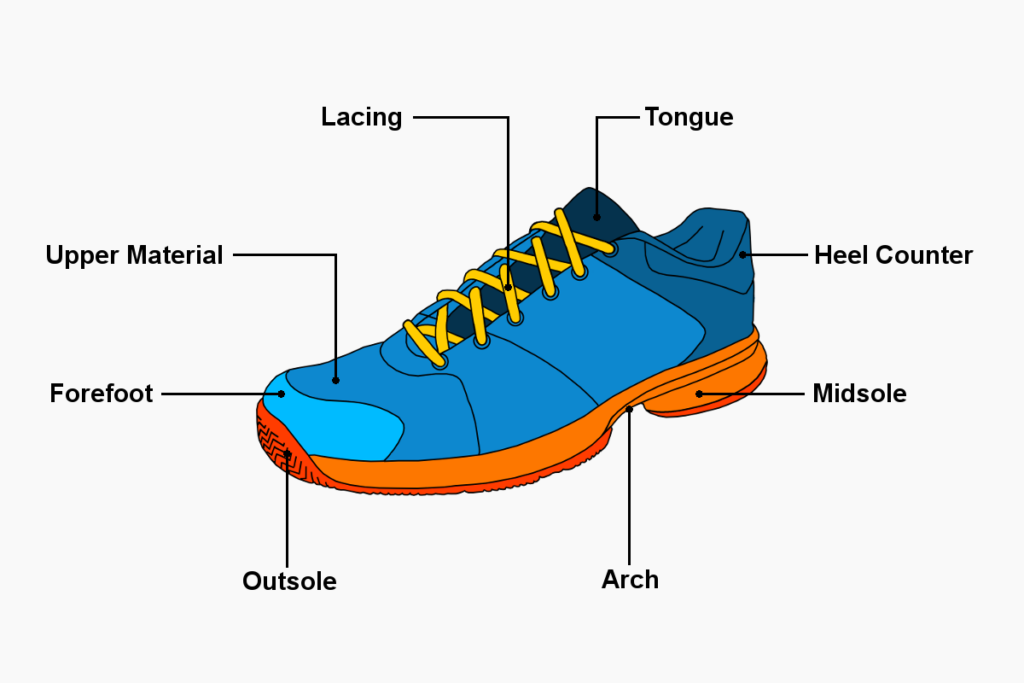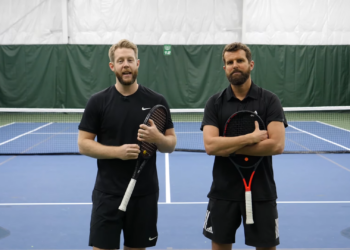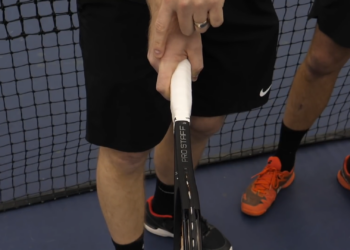Ever wondered if you can get away with wearing your trusty running shoes on the tennis court?
I hear this question all the time from players who are eager to get out there and hit but don’t want to overthink their gear. After all, a sneaker is a sneaker…right?
Well, not exactly.
Tennis is a whole different beast compared to running. It’s a game of quick pivots, explosive side-to-side movement, and constant changes in direction, sometimes in the blink of an eye.
Running shoes? They’re engineered to keep you moving forward, with cushy soles and flexible designs that are fantastic for road miles but not so great when you’re lunging to save a point at the baseline.
Wearing the wrong shoe on court is a fast track to rolled ankles, blisters, and even serious injury.
Let’s dive in, because when it comes to improving your tennis game, what’s on your feet matters more than you think.
Tennis Shoes vs Running Shoes: The Core Differences
Design & Construction
At first glance, tennis shoes and running shoes might look pretty similar, what’s under the hood makes all the difference.
The biggest divider? Lateral support versus forward-motion design.
Tennis demands sharp cuts, pivots, and explosive side-to-side moves. That’s why tennis shoes are engineered with sturdy sidewalls and reinforced uppers that lock your foot in place during those quick changes of direction.
Running shoes? They’re laser-focused on propelling you forward, with lightweight materials and lots of flex to keep you striding ahead smoothly. Great for the track – disastrous for the court.
Another key feature: the sole.
Tennis shoes have flat, durable outsoles designed to grip the court and support multidirectional movement. The tread patterns even vary based on court type (hard, clay, grass), so you get maximum traction where you need it.
In contrast, running shoes sport curved soles with deep cushioning that absorbs shock from repetitive heel strikes. On a tennis court, that curve can throw off your balance and make sharp stops and starts feel awkward and risky.
And then there’s the material game. Tennis shoes are built like little tanks.
We’re talking reinforced toe guards (for all you toe-draggers out there), thick rubber outsoles, and heavy-duty stitching made to withstand court abrasion.
Running shoes? They’re built for breathability and weight savings, with tons of mesh and flexible fabrics that just don’t hold up well under the rigors of tennis.
Cushioning & Stability

Let’s talk comfort and where tennis shoes draw a hard line.
Unlike running shoes, which often have thicker midsoles packed with plush cushioning (especially in the heel), tennis shoes are designed with thinner midsoles.
Why? Because in tennis, court feel is everything.
You need to sense every pivot, every push-off, and every split step. Too much cushion, and you’ll feel like you’re playing on marshmallows, great for your morning jog, but terrible when you’re chasing down a drop shot.
Another key factor is the heel drop, that’s the height difference between your heel and toe. Running shoes have a more pronounced heel drop to help propel you forward with each stride.
Tennis shoes? They keep things flatter, giving you a balanced stance that keeps your center of gravity low and agile.
This design is a game-changer when it comes to making lightning-fast directional shifts without tipping over.
And here’s the biggie: stability.
Tennis shoes excel at lateral support, which keeps your ankles and knees protected when you’re making aggressive cuts. This not only boosts your performance but seriously minimizes your injury risk. It’s peace of mind every time you step on court.
Weight & Flexibility
Now, I know some players worry when they pick up a tennis shoe for the first time and feel the extra heft. Yes, tennis shoes are heavier than your average running shoe, but that’s by design.
The added weight comes from sturdier materials, reinforced sidewalls, and more robust soles that keep you glued to the court when the pressure’s on.
That “heavy” feel? It’s actually your best friend out there.
It provides traction and support that lets you plant your feet with confidence, dig in for low balls, and push off explosively without worrying about slipping.
Running shoes, with their featherweight build, just can’t offer that same grounded power, you’ll notice the difference the first time you chase down a tough wide shot.
In short: that little extra weight = a big boost to your game.

Source -> Tennis Uni
Why Running Shoes Fall Short on the Tennis Court
Can You Play Tennis in Running Shoes? (Spoiler: Not a Great Idea)
You’ve got a perfectly good pair of running shoes sitting in your closet, and you’re thinking, “Why buy another pair just for tennis?”
Here’s the answer: because running shoes are built for an entirely different job.
The biggest risk? Lateral instability.
Running shoes are designed to move you forward, not sideways. The minute you make a sharp cut or shuffle hard to reach a ball, you’re gambling with a rolled ankle, a nasty slip, or even a full-on fall.
Their soft, flexible sidewalls just can’t handle the side-to-side torque of tennis.
I’ve seen it firsthand, players hobbling off court with twisted ankles after thinking their running shoes would “be fine just this once.”
One of my students, a beginner, learned this the hard way. She showed up in her usual runners, took one awkward side step, and tweaked her ankle within 20 minutes.
Not only was she out for weeks, but she also lost a ton of confidence. That’s the last thing we want for anyone picking up a racquet.
Want a quick way to test your shoes? Try this: put on your running shoes and stand in front of a mirror. Do a few side shuffles and sharp pivots. Feel that wobble? That’s your shoes telling you they’re not built for tennis.
Now do the same in a proper tennis shoe, solid, stable, and no side-to-side give. That’s what you need to stay safe and sharp on court.
What Happens to the Court & Your Shoes
It’s not just your body at risk when you wear the wrong shoes, it’s the court, too.
Many running shoes come with aggressive tread patterns and black rubber soles that can scuff up or even damage tennis courts. Clubs and facilities don’t take kindly to this.
I’ve heard of players being pulled off the court mid-match because their shoes were leaving marks.
And here’s another kicker: your beloved running shoes will get trashed way faster on a tennis court.
Tennis surfaces are abrasive, especially hard courts, and they chew through the soft outsoles of running shoes in no time. You’ll see wear patterns appear fast, and that plush cushioning you love? It flattens out even quicker under the multidirectional pounding of tennis.
The Performance Edge: How Tennis Shoes Make a Difference
Safety & Injury Prevention
Let’s get one thing straight: tennis shoes are a must-have if you want to keep playing safely.
The right pair of tennis shoes is designed to reduce the risk of sprains, rolled ankles, and even blisters.
Thanks to features like lateral support, reinforced toe caps, and padded collars, tennis shoes cradle your foot securely, preventing that dreaded sliding around inside your shoe when you make a quick cut.
Less friction = fewer blisters, and stronger support = fewer trips to your physical therapist.
FAQ: Do tennis shoes for kids follow the same principles as adult designs?
Absolutely.
In fact, it’s even more important for kids because they’re still developing coordination and muscle memory.
Kids’ tennis shoes are built with the same emphasis on lateral stability, non-marking soles, and reinforced designs, just sized down to keep your little future champ safe and confident on court.
Boosting Speed & Balance
Beyond safety, tennis shoes give you a serious performance edge.
Each pair is crafted to grip the court differently depending on the surface.
For hard courts, you’ll find durable rubber outsoles with herringbone patterns that balance grip and give, preventing slips but allowing quick pivots. Clay court shoes have tighter tread patterns that keep clay from clogging up your soles, while grass court shoes focus on small nubs for traction on slick, grassy surfaces.
And then there’s the shoe tech that really makes a difference:
- Toe drag guards protect both your shoes and your toes when you’re stretching wide for a ball.
- Symmetrical tread patterns ensure you get equal traction whether you’re moving left, right, or backpedaling – valuable when every split second counts.
With tennis shoes, every element is designed to keep you fast, balanced, and in control.
Running shoes? They’re just not built to keep up.
Longevity & Investment
I know one of the biggest questions players ask is, “Are tennis shoes really worth the investment?”
My answer? 100% yes, especially if you value your health and wallet.
Many tennis shoes come with outsole durability guarantees, sometimes six months or more, because they’re built to take a beating.
Compare that to running shoes, which often start breaking down after 300 miles (or way sooner if you wear them on court).
Tennis courts are unforgiving, and a proper tennis shoe is reinforced to handle that daily grind without falling apart.
And let’s talk value: even if you’re a casual player, investing in the right tennis shoes now saves you from replacement costs, injuries, and frustration later.
It’s a small upfront cost for peace of mind, better performance, and longer-lasting gear.
Questions Players Ask (And Answers You Need)
How do tennis shoes vary by court type?
Tennis shoes are specifically designed to match the surface you’re playing on.
For hard courts, you’ll want shoes with durable outsoles and reinforced toe caps – they’re built to withstand the roughest surfaces.
Clay court shoes have tighter herringbone tread patterns to prevent clay buildup and help you slide controlled (not wipe out!).
Grass court shoes? They’re equipped with small nubs to dig into slippery grass and give you the traction you need when the court gets damp.
If you bounce between surfaces, an all-court tennis shoe is a great versatile pick.
Is there a shoe that works for both running and tennis?
Honestly? No perfect solution.
While some cross-training shoes claim to bridge the gap, they’re usually a compromise, better than running shoes for tennis, but still not ideal.
If you’re playing tennis regularly, your safest bet is to invest in dedicated tennis shoes. Your feet (and ankles) will thank you.

Source -> New Step Podiatry
What’s the science behind the rubber compounds in tennis shoes?
Here’s where things get fun. Tennis shoe outsoles are made from high-abrasion, non-marking rubber that grips without scuffing the court surface.
Brands tweak their rubber formulas depending on the surface, for example, harder compounds for hard courts, and softer, tackier blends for clay or grass.
The science is all about balancing traction, durability, and flexibility so you can move explosively without slipping or grinding down your shoes too fast.
Can tennis shoes help me level up my speed and agility?
Absolutely. Think of tennis shoes as an extension of your body, they’re designed to maximize your court connection.
The low-to-the-ground build, firm sidewalls, and specialized tread patterns all work together to keep you quick, stable, and balanced.
I’ve seen countless players unlock new levels of movement and confidence just by switching to the right shoes. It’s one of the easiest, and smartest, upgrades you can make to your game.
Best Tennis Shoe Picks at Every Budget
Budget-Friendly ($50–$80)
If you’re just starting out or playing casually, this is a great price range to get your feet on court without breaking the bank.
The pros? These shoes give you the neededl lateral support, non-marking soles, and reinforced construction you need to stay safe and comfortable.
The cons? You might sacrifice a bit on durability and advanced cushioning, and the materials may wear faster, especially on hard courts.
Example picks:
- Adidas Gamecourt 2 – A reliable entry-level shoe with solid traction and a lightweight mesh upper.
- K-Swiss Court Express – Well-padded and supportive, great for recreational play on multiple surfaces.
Mid-Range ($80–$130)
This is the sweet spot where performance and value meet.
Mid-range tennis shoes pack in more advanced features like durable outsoles (sometimes with a warranty), improved cushioning, and surface-specific traction patterns.
These are ideal for improving players who are starting to play more regularly and want a shoe that can keep up with faster footwork and longer rallies.
Example picks:
- ASICS Gel-Resolution 9 – Excellent durability, comfort, and lateral support with a proven performance track record.
- NikeCourt Air Zoom Vapor Pro – Lightweight with responsive cushioning and superb grip for aggressive movers.
Premium ($130+)
This is where elite performance tech shines.
Premium tennis shoes bring you the best in court-specific engineering – maximum durability, plush cushioning, pro-level lateral stability, and precision fit.
These models are often endorsed by top ATP and WTA pros and are built to handle intense competition and heavy play.
Example picks:
- Babolat Propulse Fury 3 – Built like a tank for aggressive baseliners; features reinforced zones and a Michelin outsole for ultimate grip.
- NikeCourt Zoom Vapor Cage 4 Rafa – Worn by Rafael Nadal himself, offering a perfect balance of power, durability, and agility for serious competitors.
Are they worth it? If you’re playing regularly or pushing your limits, investing in premium shoes can enhance performance and reduce injury risk, making them well worth it.
PlayYourCourt has its own marketplace stocked with a wide range of tennis shoes, racquets, clothes, and more.
Even better? As a PlayYourCourt member, you automatically get exclusive savings, no need to wait for a sale.
We’ve got options for every type of player and every budget, so head over to the marketplace, check out the latest picks, and grab the tennis shoes that will keep you moving strong.
Is It Time to Upgrade Your Shoes?
While running shoes excel at keeping you moving forward on the track, they fall flat on the tennis court – literally.
Tennis demands multi-directional movement, rapid pivots, and explosive cuts that running shoes just aren’t built to handle. That’s why tennis shoes trump running shoes every time when it comes to safety, balance, durability, and game-day performance.
The right shoes don’t just protect your ankles and knees; they unlock better footwork, sharper cuts, and greater confidence every time you step on court.
And hey, you don’t have to navigate this decision alone. PlayYourCourt helps players like you improve faster and play smarter.
Whether you’re unsure if your current shoes are up to the task, or you’re ready to find your perfect pair, we’ve got your back.
Check out our 7-day free trial membership where you’ll not only access pro coaching and challenges but also get exclusive savings on top tennis gear in our marketplace.
Let’s get you set up with the right shoes, and the right tools, to keep improving, injury-free.
See you on the court soon. 💪🎾



